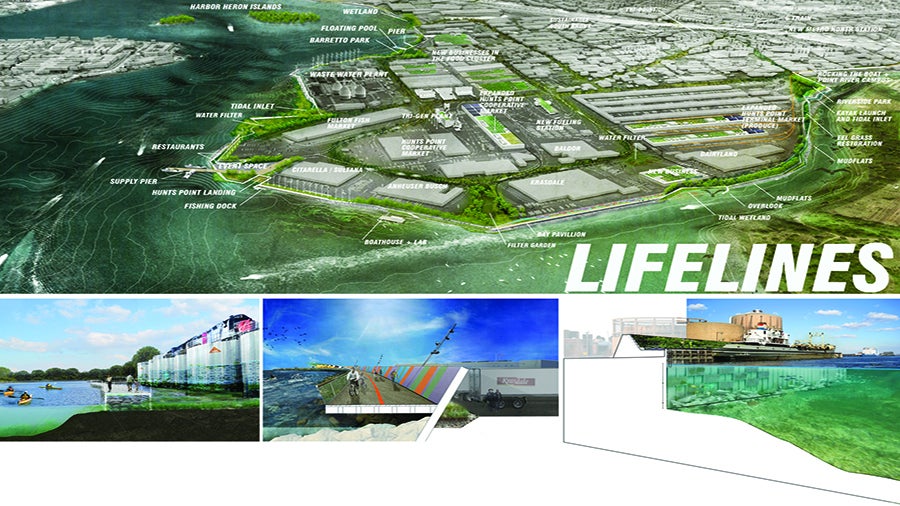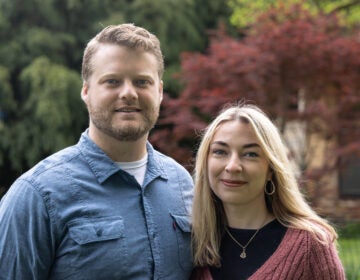HUD names PennDesign/OLIN’S “Hunts Point | Lifelines” winner in Rebuild by Design competition

WASHINGTON, DC–The Hunts Point | Lifelines proposal has been selected as one of six competition winners for the U.S. Department of Housing and Urban Development’s Rebuild By Design Competition. The project, developed by the University of Pennsylvania School of Design and OLIN, has been selected to receive $20 million of HUD’s Community Development Block Grant Disaster Recovery funding.
The PennDesign/OLIN team developed Hunts Point | Lifelines in response to a year-long, multi-stage design competition, a 2013-14 initiative of President Barack Obama’s Hurricane Sandy Task Force, which brought together architects and urban designers, landscape architects, engineers, researchers, elected officials and community stakeholders to advance research-based and innovative design strategies to create a more resilient future for the coastal areas affected by the superstorm.
The PennDesign/OLIN team combined their strengths in research, planning, landscape architecture, engineering and implementation to envision an integrated flood protection plan for Hunts Point in the Bronx, New York City. Home to New York City’s major food distribution center, Hunts Point is a major economic hub, supporting over 25,000 jobs and $5 billion in annual direct economic activity. The peninsula’s wholesale produce, fish and meat markets are also a key link in the regional food chain, feeding more than 22 million people in the tri-state area.
“The Rebuild by Design challenge is a bold move on the part of HUD Secretary Shaun Donovan and his colleague Henk Ovink to put informed design at the center of meeting the challenges of extreme weather,” said Marilyn Jordan Taylor, Dean of the School of Design at the University of Pennsylvania and Special Advisor to the competition. “I’m delighted that the PennDesign/OLIN team is among the winners and that funds will flow to advance this exciting vision for the Hunt’s Point economy and community.”
The multi-disciplinary team led by PennDesign and OLIN was selected in August 2013 as one of ten finalists invited to develop a proposal addressing storm resilience in the areas severely affected along the East Coast from southern New Jersey to Rhode Island. In December 2013, PennDesign/OLIN was advanced to the design stage, based on its research-proposals for the Hunt’s Point site identified as an economically vulnerable area also at risk to extreme weather events. The plans that emerged from months of work with community members and business interests were submitted to HUD in March 2014.
“Hunts Point is a great place to solve the human problem of resilience-to stimulate a culture shift and a new way of looking at working waterfronts and their communities,” Ellen Neises, team member and instructor at PennDesign, said. “Lifelines incorporates businesses and the community into the design of a project that builds on the special character and capacity of the place–ensuring that the value of resilience investments is felt every day and that New York’s waterfront works. This money puts Hunts Point on the map of places that people are focused on.”
The proposal includes a dynamic and experimental flood protection levee to keep the peninsula dry while providing waterfront greenway for the everyday use of the community. Demonstrating that even short-term disruptions caused by a storm event could be catastrophic to the region’s safe and stable food supply, the PennDesign/OLIN team put a spotlight on the importance of living wage jobs and a reliable food supply and distribution system as critical resilience infrastructure. The team also proposed new pier infrastructure that supports a federal plan to create marine highways and improve the East Coast’s disaster preparedness. Overall, the team looked to protect the long term health of the region by protecting existing jobs and generating new ones in one of the city’s high-value industrial waterfronts.
“By having a broad and open conversation about what resiliency means for Hunts Point,” team member and OLIN partner Richard Roark explained, “we realized our design needed to do more than just flood protection. It had to become a catalytic opportunity for a whole host of things relating to the long term sustainability for both the peninsula and the region.”
Hunts Point | Lifelines was forged together with strong community partnerships. With the Point Community Development Corporation providing a forum for the residents and multiple community groups of Hunts Point, the team was able to engage community stakeholders, organized labor and business owners to inform ideas for integrated storm protection and green infrastructure. Taken together, the emerging designs formed a framework that offers high-quality social space, restored habitat and clean water and long-term industrial jobs to benefit both the peninsula and the region.
Hunts Point | Lifelines will achieve regional significance by demonstrating the productivity and vitality of a protected working waterfront that is integrated with dynamic public use, new habitat, and local livelihoods. Although the Hunts Point Food Distribution Center is a unique asset and essential piece of public infrastructure, the PennDesign/OLIN focus on jobs, quality of life and local ecology has wide applicability in other floodplain industrial communities.
“Rebuild by Design was a chance for us as landscape architects to think upstream, when the problem was still being defined,” states OLIN CEO and Partner and PennDesign Adjunct Professor Lucinda Sanders. “And that’s huge, because designers are all capable of doing that but rarely asked.”
The PennDesign/OLIN design team includes: PennDesign, OLIN, HR&A Advisors, eDesign Dynamics, Level Infrastructure, Barretto Bay Strategies, McLaren Engineering Group, Philip Habib & Associates, Buro Happold, and local community partner The Point Community Development Corporation.
###
PennDesign
Megan Schmidgal
215.898.2539
OLIN
Kristen Knese
215.440.0030 x403
WHYY is your source for fact-based, in-depth journalism and information. As a nonprofit organization, we rely on financial support from readers like you. Please give today.






